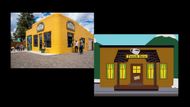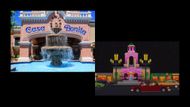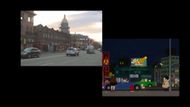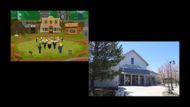The name South Park, at first glance, doesn’t sound particularly special. It’s plain. Two short words, nothing grand. It could be the name of any neighborhood or park tucked away in some small town. And maybe that’s why it works. It doesn’t call attention to itself. It slips into the background, unnoticed, at least until someone turns it into the title of one of the most infamous animated shows ever made.
So here’s the thing. South Park, the show in the town, isn't exactly real. But the idea of it is. The name came from somewhere, and the creators didn’t just invent the setting from scratch. They pulled pieces from a very real part of Colorado, shaped them into something exaggerated, and let the absurdity grow from there. That’s where it gets interesting. Because even though the current version is full of chaos, the place that inspired it is quiet. Almost too quiet.

Not entirely fiction, not fully real either
It helps to look at a map while dealing with such an issue
. Somewhere in the middle of Colorado, there’s a stretch of land known as the South Park Basin. It’s not a town, not in the way most people think. It’s a valley: big, open, surrounded by mountains. One of those areas that people might drive through without realizing has a name at all. It's the kind of landscape that disappears into itself when covered in snow.
There’s no official city of South Park. But there is a town called Fairplay right in the middle of the basin. It’s small. Like, really small. It also has a couple hundred buildings with a population that doesn’t hit four digits. A few local shops, some diners, a post office. That’s pretty much it. And yet, this little place is often seen as the inspiration for the fictional South Park place in the show. If you compare the two in terms of their the general layout, the isolation, even the cold, it all lines up.
The setting of the animated show isn’t just about where it takes place geographically. It’s also about the feeling. It's about the sense that life is happening somewhere off to the side, not in the spotlight; that things are unfolding quietly, until they’re not. That’s what Fairplay offers. Not much on the surface. But it sets the stage.

A valley that gave something to talk about
The real South Park Basin is a place of stillness. No big roads cutting through, except for the US-285 that slices past the edge. No flashing signs. Not many reasons to stop unless you’re headed there on purpose. But that’s part of the charm.l and mystery. Perhaps this is just the reason it worked so well as a fictional backdrop.
In Fairplay, there’s a spot called South Park City. It’s a recreated mining town, open to visitors. It is kind of like a museum, but outdoors. Everything looks like it came out of the 1800s: wooden sidewalks, old-lookimg buildings, iron tools in the windows and so on. There’s a strange sense of time folding in on itself when you walk through it. It’s all staged, of course, but still feels oddly lived in.

Real places slip into the story
The episodes of South Park are full of strange events. Most of them are way over the top, clearly not meant to be taken literally. But every now and then, something real slips into the story and one of the best examples is the episode titled "Casa Bonita." The episode built around the place Casa Bonita isn’t just using the name for laughs. The place actually exists: a restaurant in Lakewood with waterfalls, cliff divers, caves you can walk through. It’s bizarre in a way that feels almost fictional on its own.
In fact, Trey Parker and Matt Stone grew up nearby. Casa Bonita wasn’t just a restaurant for them. It was part of their childhood - something specific, something that remained. Later on, they bought the real one, and restored and reopened it. Now it’s a place fans can visit, eat at, and remember watching as part of an animated and (almost) fictional storyline.
Other real-life locations appear too, though more subtly. There's a stretch of Colfax Avenue, a glimpse of Coors Field, and hints of places only locals would recognize. However, they aren't highlighted as such. It's more like the writers are reminding viewers that even the weirdest stories have a little bit of truth hiding underneath.

The setting that never changes, even when everything else does
South Park has been around since the late 1990s, it's first episode released on August 13, 1997. That alone is unusual. Not many shows last that long, especially not ones built on controversial humor and storylines that push boundaries. But something about it keeps working through time, and the show's setting is a big part of that.
The town itself never changes. The characters do age but in theory, somehow remain the same. The houses look the same. The school, the bus stops, the snowy hills in the background, they’re all frozen in time. And that’s the point. This plot device lets the writers bring in whatever contemporary elements they want, celebrity scandals, political messes, social media trends, and toss them into this town that never reacts the way people expect.
The contrast between a quiet mountain town and the madness that takes place there keeps the show grounded, weirdly enough. If it were set in a big city, none of it would land the same way. The absurd needs that calm foundation to really hit.

What’s next is hard to guess, but something always keeps coming up in South Park
The show doesn’t follow a strict formula anymore. Some seasons have long arcs. Others are full of one-off episodes. Specials pop up when no one’s expecting them. But the core stays intact. The town, the group of kids, the way things feel both stuck and chaotic all at once.
Trey and Matt still run the show. Still voice the characters. Still write most of the material. That consistency matters. Even when the content shifts, the voice stays recognizable. And now, with the real-world projects like Casa Bonita in their hands, the boundary between fiction and reality feels thinner than ever.
There’s no way to predict what kind of episode comes next. It might focus on something happening globally. Or something so small and local it feels like an inside joke. Either way, it’s going to pass through that filter, small-town weirdness mixed with cultural commentary.

South Park: a made-up place with real pieces
At this point, South Park isn’t just a show. It’s also a place that people feel like they know. Even if they’ve never been to Colorado, even if they’ve never heard of Fairplay, something about the show makes that town feel real.
Maybe it’s because of the snow. Or the way the houses look. Or the silence that sits behind the louder parts of the story. The town feels like it could exist somewhere, just far enough away that no one really notices which mandates the willing suspension of disbelief and part of the magic.
South Park pulls from real geography, real names, real roads. Then it adds in talking characters, wild plots and impossible situations. But the base stays steady. That’s what holds the whole thing together. If the setting were just chaos layered on top of chaos, the show probably wouldn’t have lasted this long.

Conclusion
South Park, the town on screen, can’t be found on any map. But it’s not just fiction either. It is inspired from a real place and got its tone from cold streets, quiet towns and the kind of spaces where people keep to themselves. Fairplay, South Park Basin, Casa Bonita, all those names carry weight because they helped build something that became bigger than the sum of its parts.
There’s no welcome sign, no actual border here. Still, the town exists in the minds of viewers, in a valley somewhere in Colorado, and in every episode that starts with a quiet street and ends in complete, absurd mayhem.
